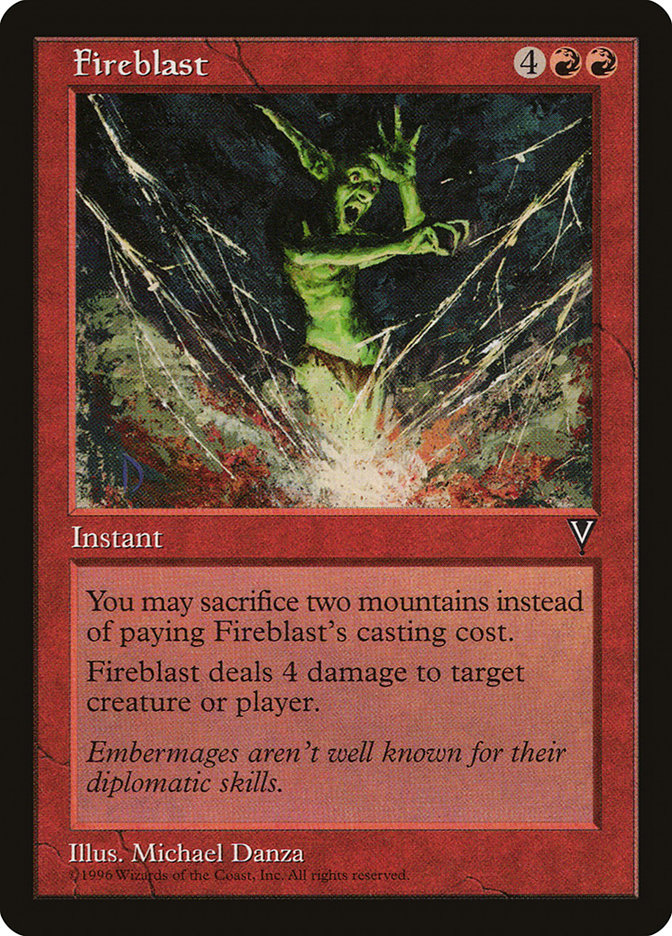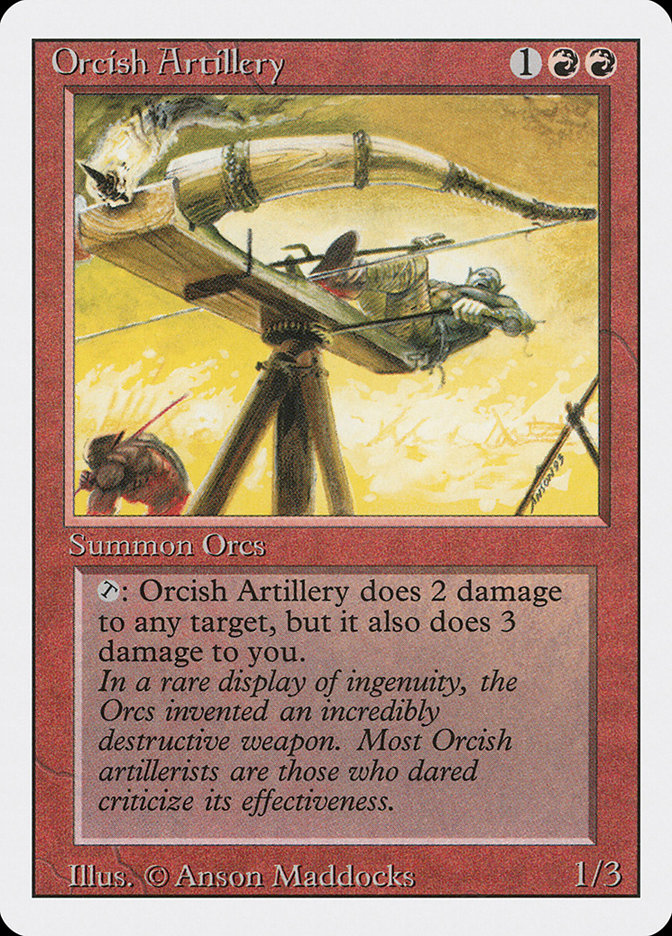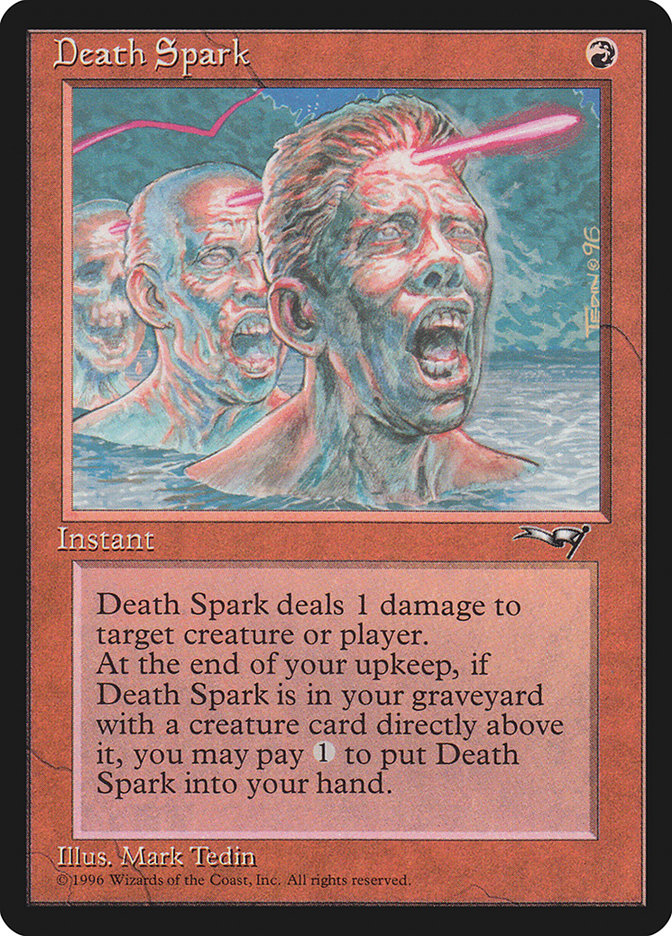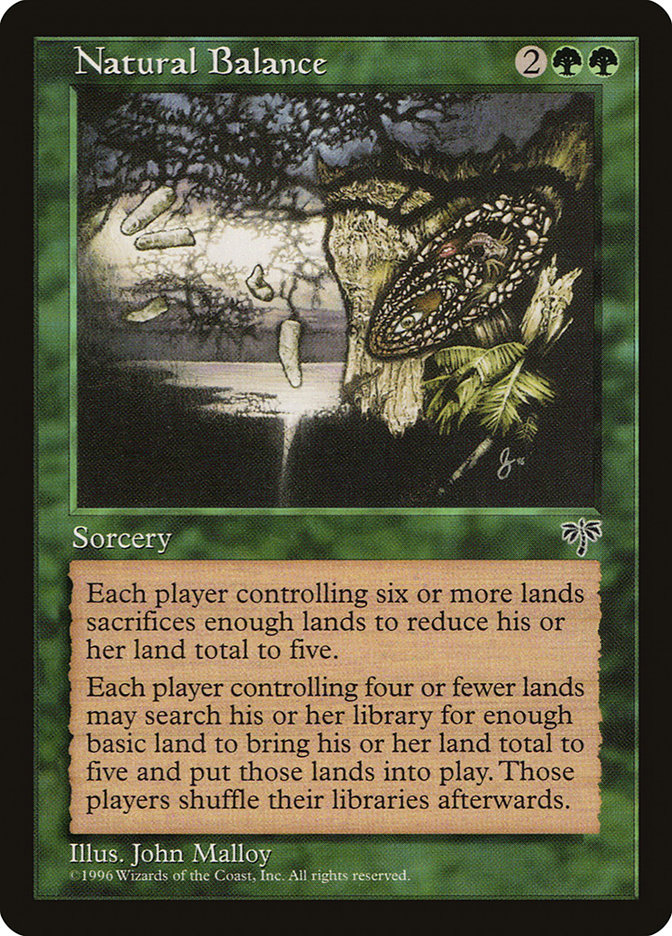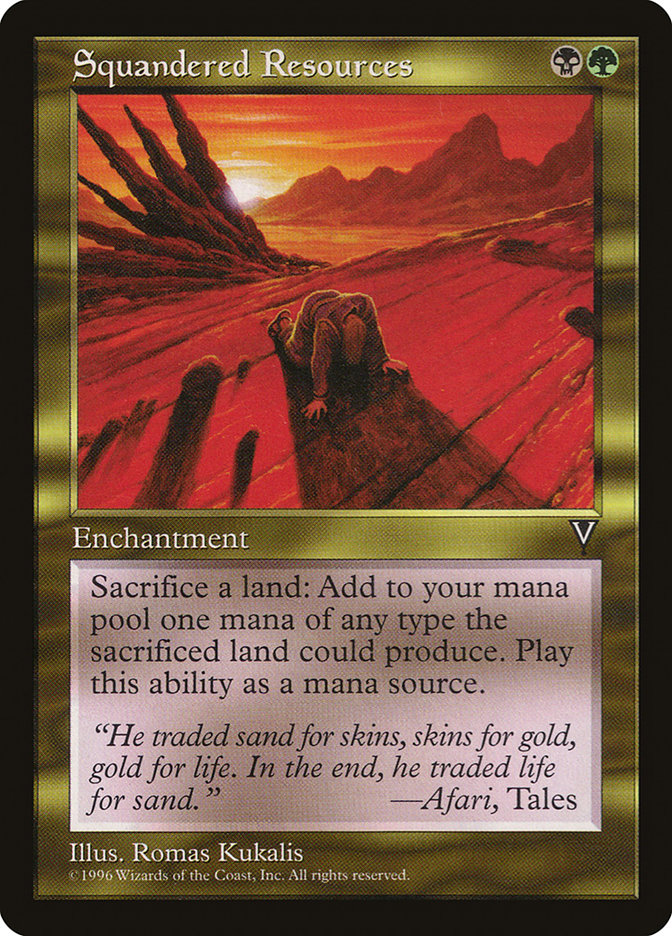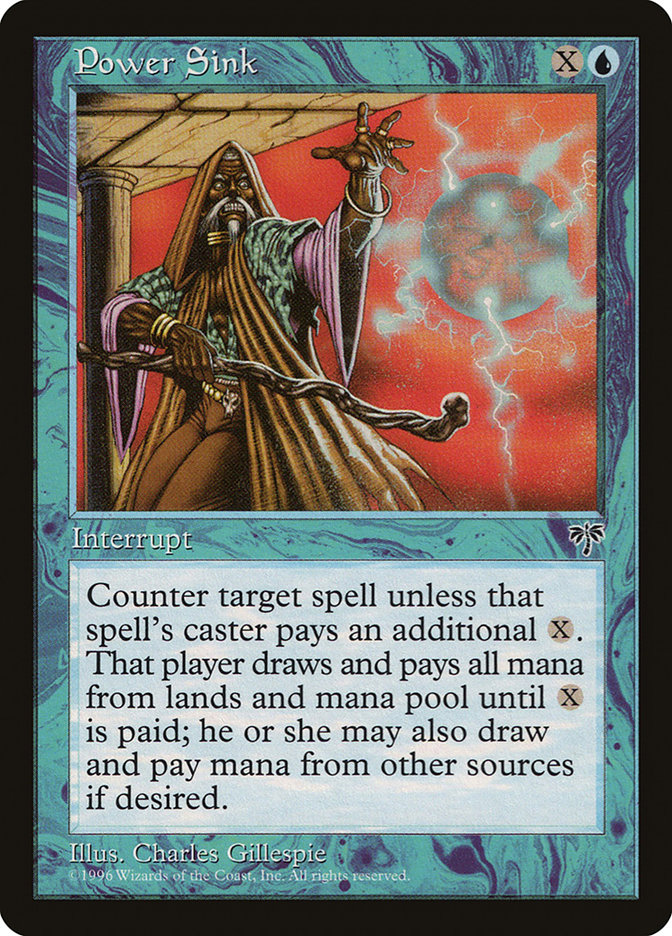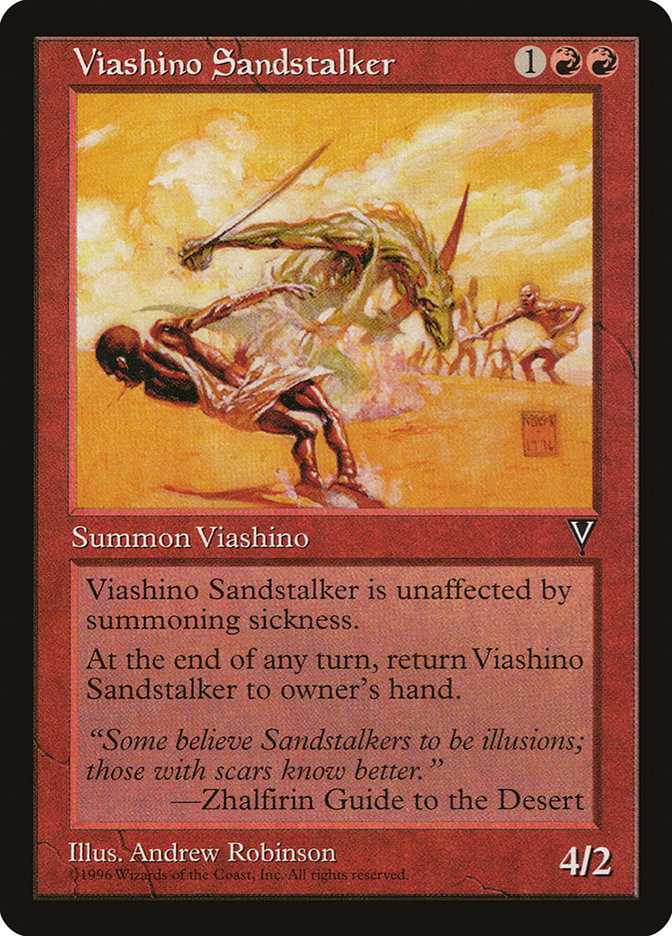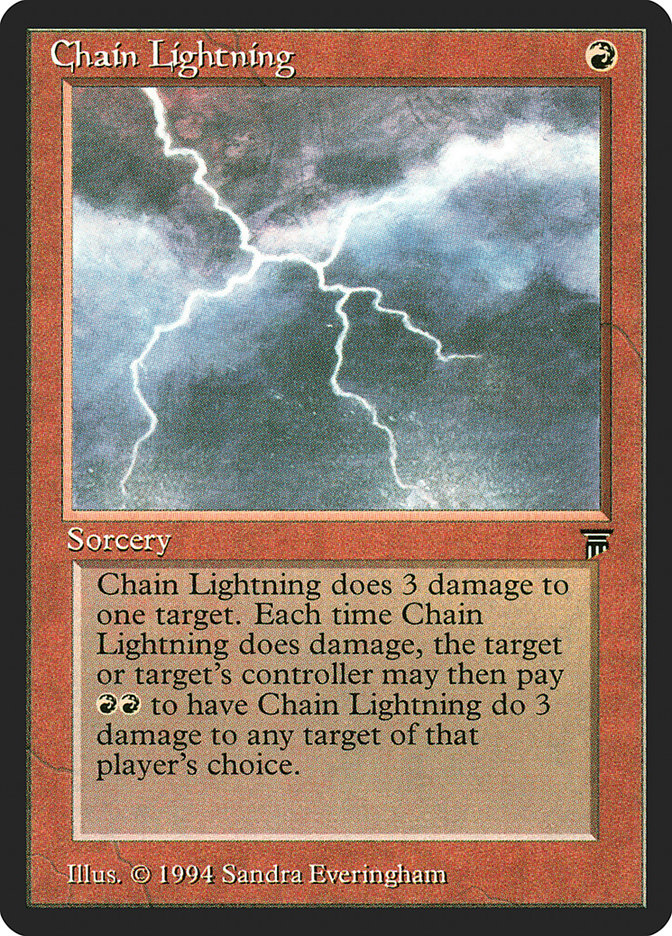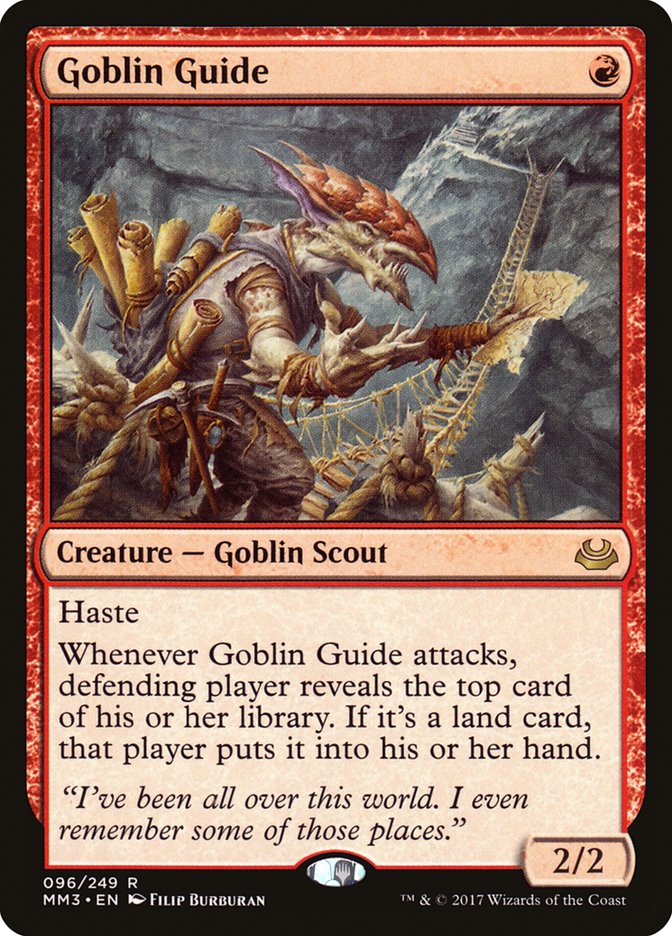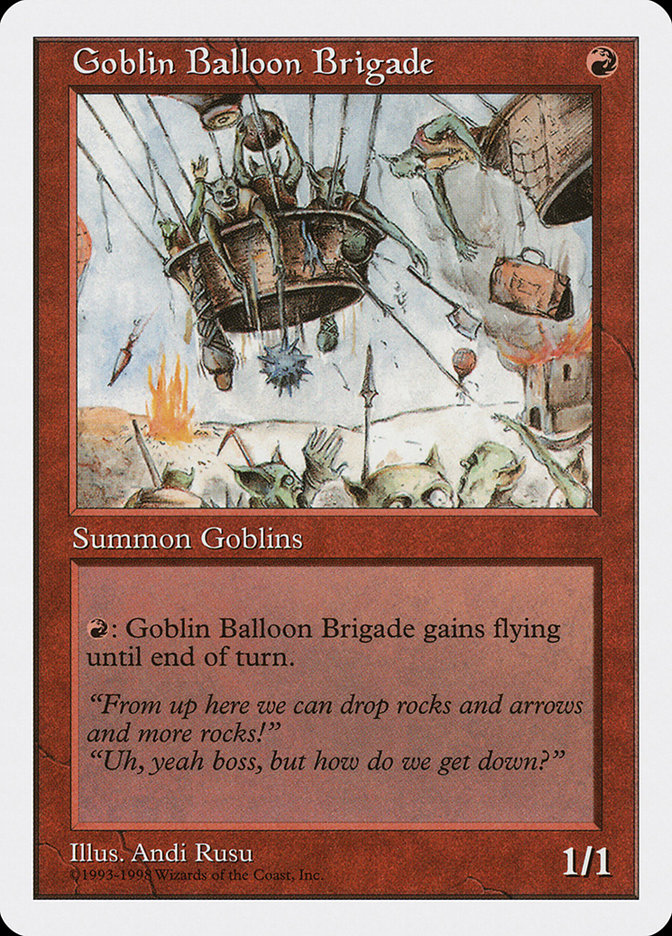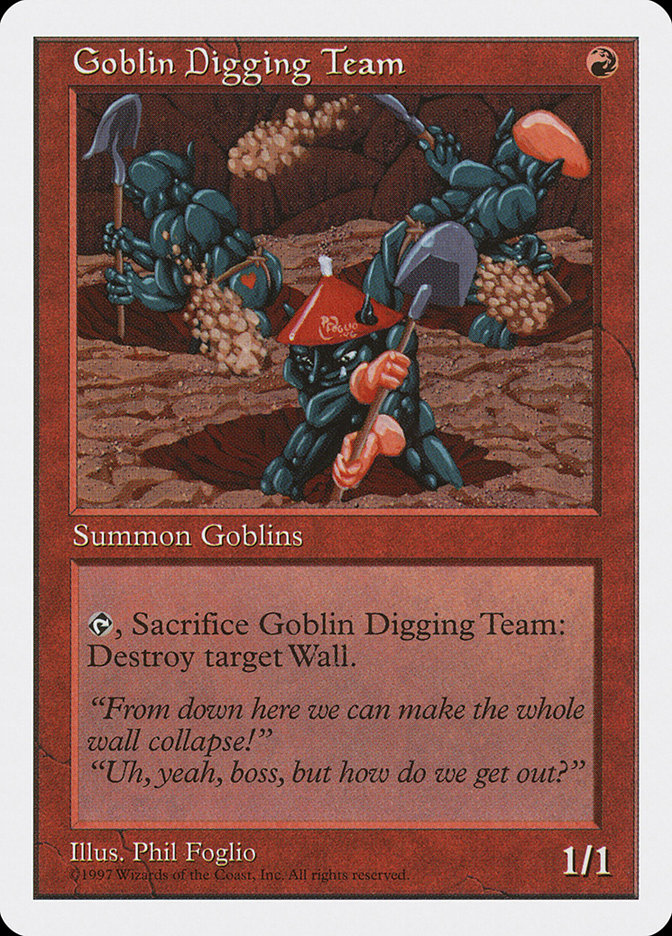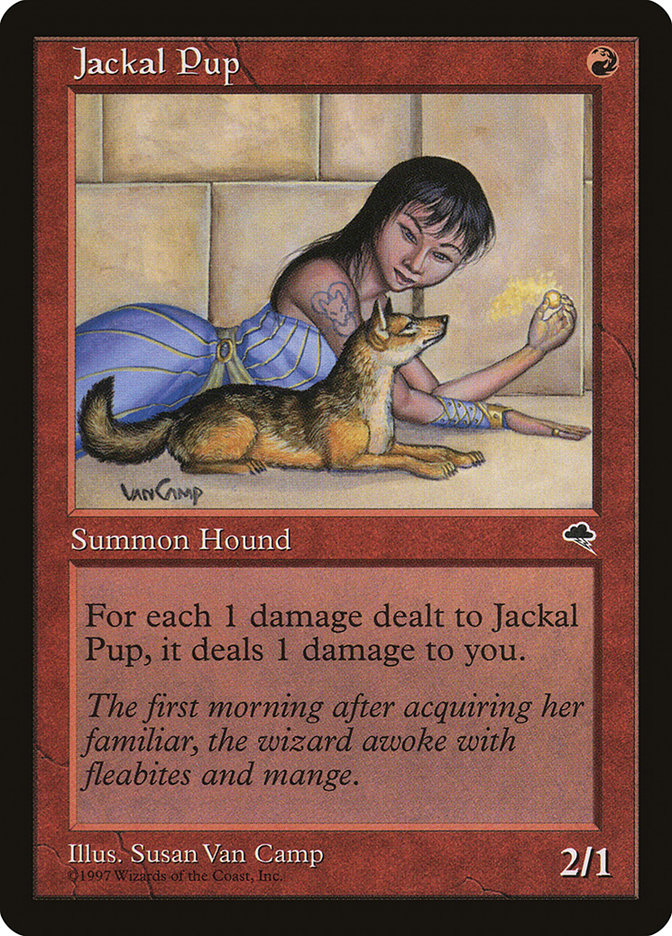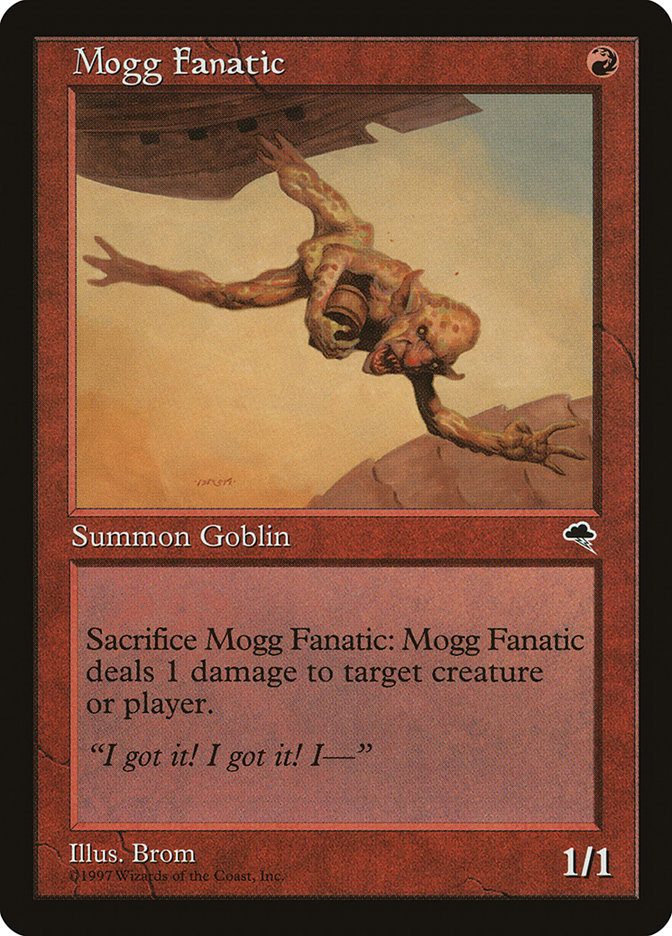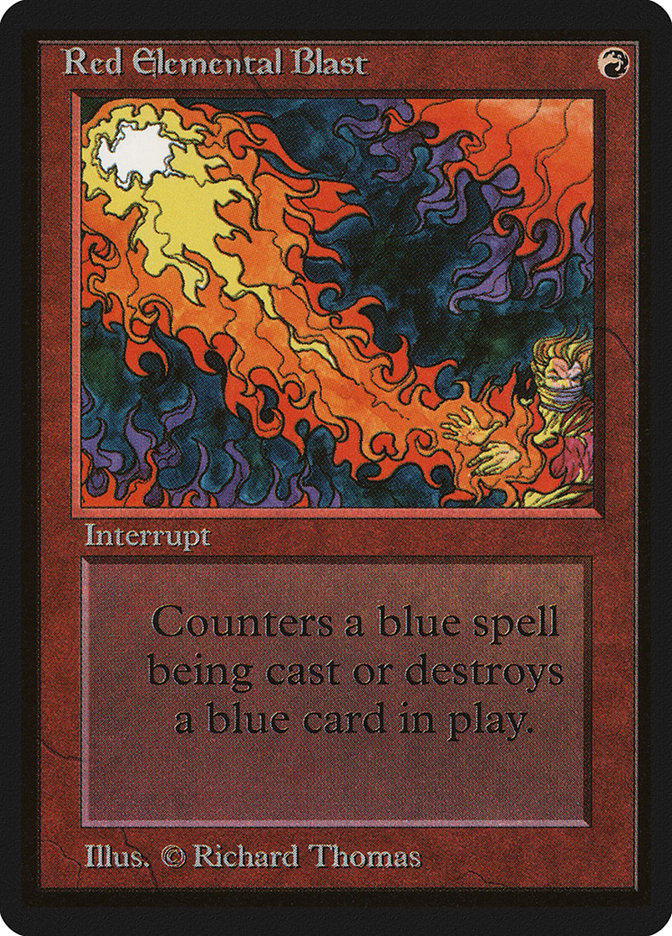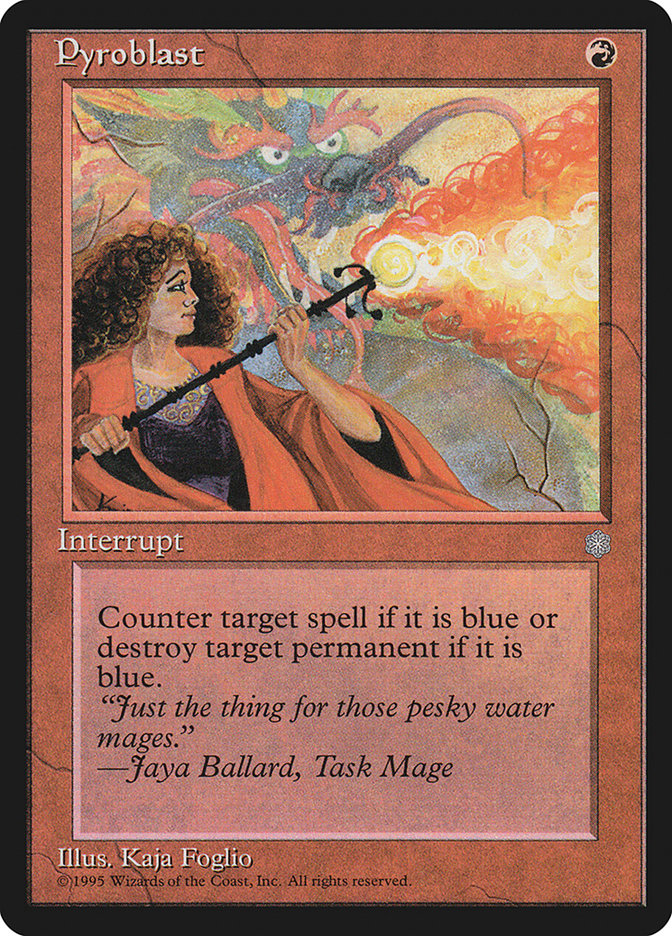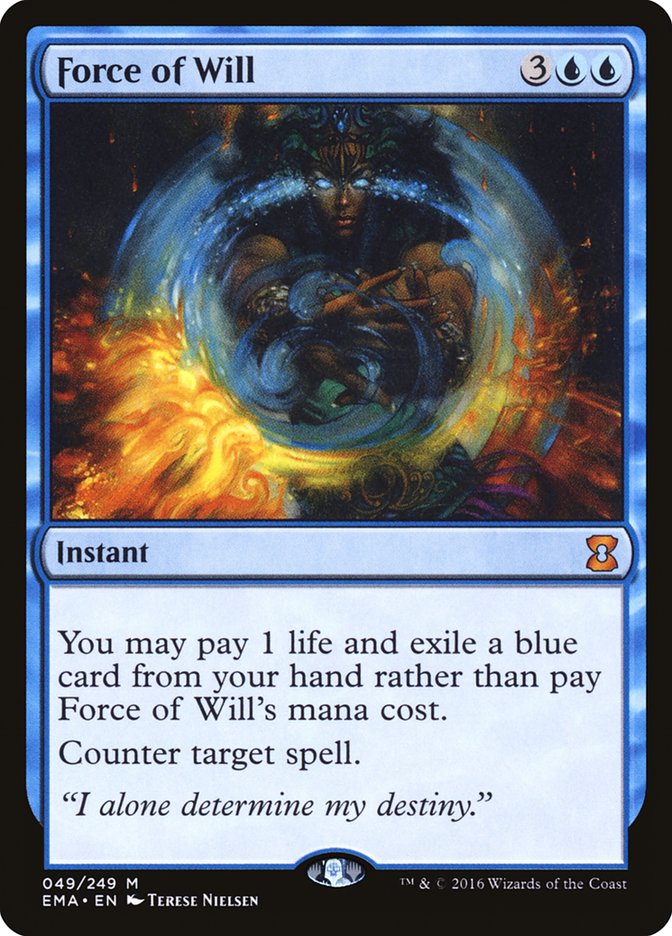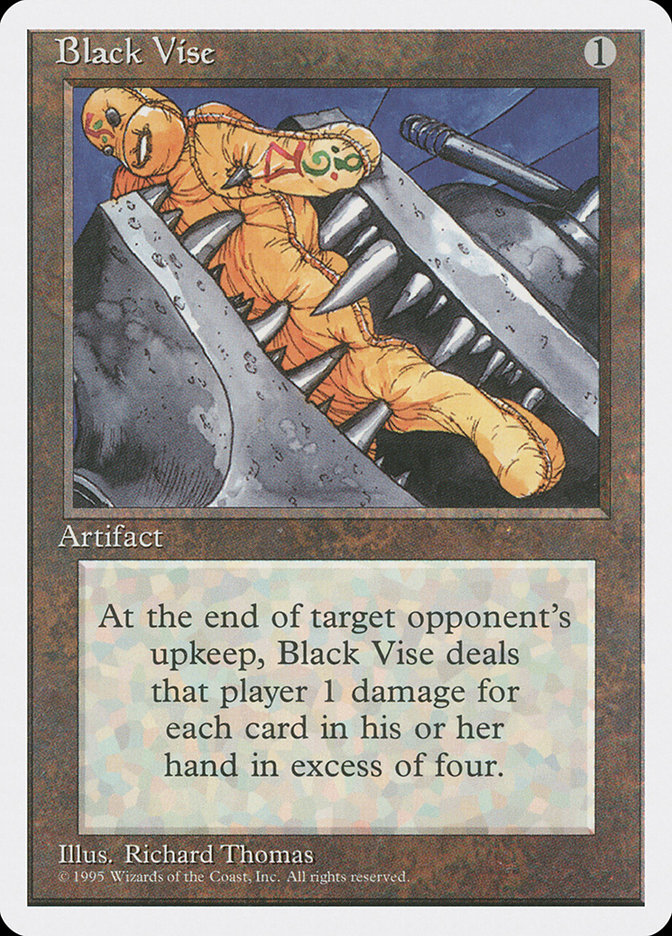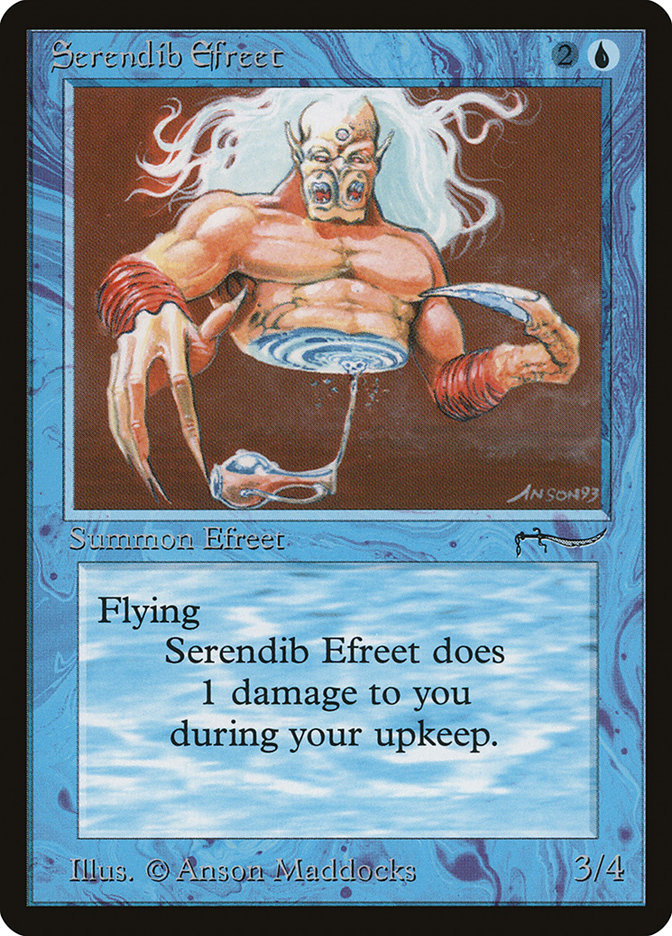The top 25 red cards of all-time most certainly involves a fair number of
burn spells, and today’s first card is not only one of the best burn spells
in the game’s history but one of its most historically significant.
#10: Fireblast
Fireblast marked the beginning of a new era.
You see, for the first couple years of Magic, the color red was largely a
support color, primarily contributing burn spells, artifact and land
destruction, and a variety of niche spells for special occasions. Once in a
while, you might see a Shivan Dragon or Kird Ape, but the color largely
bore little resemblance to the red we know today.
By late 1996, the first year of the Pro Tour, a new perspective on red was
formed, thanks to Jay Schneider’s Sligh deck. Here, cheap, mediocre red
creatures were coupled with burn for interaction to enable an aggressive
battlefield control deck with some midrange properties. Players would often
assume it was more aggressive than it really was, then be surprised when
the red deck took over the game with Orcish Artillery and Death Spark.
However, this brief golden age of red battlefield control decks was
short-lived. Barely a few months after Sligh took the world by storm, Visions was released, bringing with it Fireblast.
Fireblast was underestimated by many at first. After all, how much did you
really want to sacrifice your lands to cast it anyway?
The thing is, sacrificing your lands was no cost at all if it ended the
game. While there were a fair share of “Fireblast in response to Armageddon
or Balance” moments and sometimes you’d have to Fireblast the Sengir
Vampire brickwalling your team, the majority of Fireblasts were played as
part of a lethal volley.
Visions
debuted at Pro Tour Paris in early 1997, the Mirage block
Constructed Pro Tour best known for Mike Long defeating Mark Justice in the
finals with a Cadaverous Bloom/Squandered Resources/Prosperity combo deck.
While Long’s Bloom deck was, without question, the more influential of the
two, most players don’t realize it was Mike Long that actually designed
Justice’s second place “Voodoo” deck as well.
Creatures (15)
Lands (15)
Spells (30)
- 1 Hammer of Bogardan
- 10 Mountain
- 4 Fireblast
- 4 Coercion
- 1 Necromancy
- 1 Stupor
- 4 Incinerate
- 1 Snake Basket
- 3 Kaervek's Torch
- 1 Kaervek's Spite
Sideboard

The Voodoo deck was a R/B aggro deck before R/B aggro was a thing, with a
healthy dose of burn for interaction that could be used to reduce the
clock, and access to eleven discard spells after sideboarding, in order to
combat Bloom-Drain decks.
Fireblast was particularly important in this deck for combating Bloom-Drain
decks, on account of its strength against Natural Balance.
Natural Balance was used by the Bloom-Drain decks to generate incredible
amounts of mana with Squandered Resources. The Bloom player would tap all
their lands, sacrifice them all, then Natural Balance, effectively making
ten more mana.
Fireblast threw a monkey wrench in things, big time. Playing a Fireblast in
response to a Natural Balance didn’t just offset the sacrifice two
Mountains cost, it actually netted two mana, since the lands from Natural
Balance entered the battlefield untapped.
While Bloom decks could generally tap people out with Power Sink, ensuring
it was safe to go off on the following turn, Fireblast meant Justice could
drop down to three land, then go find two more land and actually follow up
with an Incinerate or possibly even Funeral Charm.
Visions
was the beginning of a new era of red decks, and not all were so
“interactive.” While Viashino Sandstalker and other aggressive red
creatures found a variety of homes, the one we typically remember first was
the first true Red Deck Wins, Deadguy Red.
Creatures (23)
- 4 Goblin Vandal
- 4 Ball Lightning
- 4 Ironclaw Orcs
- 3 Goblin Digging Team
- 2 Dwarven Soldier
- 2 Viashino Sandstalker
- 4 Lava Hounds
Lands (4)
Spells (33)
Sideboard

This was the moment the red decks dropped the act. This was the birth of
what we now consider red aggro, fast red threats curving out and maximizing
damage, with burn to clear the way and eventually to provide the reach
necessary to finish the job.
#9: Chain Lightning
The Fireblast decks above and the Sligh decks just before were not the
first red decks, of course. In the first year of Magic, red aggro decks
existed; it’s just that archetypes weren’t particularly well-defined. Magic
theory had a long way to go, and besides, the cards available year one
spoke to a very different game than Visions-era Magic, let alone
the Magic of today.
The very first Magic World Championship was a 512-player single-elimination
showdown (best two out of three), held one year after the game’s debut. Zak
Dolan ended up taking the title with an
exotic
“Bant” Control deck
, featuring an extremely diverse array of interaction and denial. In
retrospect, his opponent in the finals piloted a list many of us would
likely have preferred:
Creatures (12)
Lands (20)
Spells (29)
- 4 Fireball
- 4 Lightning Bolt
- 1 Icy Manipulator
- 1 Sylvan Library
- 1 Control Magic
- 1 Regrowth
- 1 Mind Twist
- 1 Demonic Tutor
- 1 Time Walk
- 1 Chaos Orb
- 1 Ancestral Recall
- 1 Channel
- 4 Chain Lightning
- 2 Psionic Blast
- 1 Black Lotus
- 1 Mox Emerald
- 1 Mox Jet
- 1 Mox Ruby
- 1 Mox Sapphire
Sideboard

Lestree’s deck was an early foundational piece of Magic technology, giving
birth to the first Zoo deck (so named for the Kird Apes and Savannah Lions
that would go on to replace Argothian Pixies). Cheap, aggressive creatures,
with Lightning Bolts and Chain Lightnings helping clear the way.
Chain Lightning may generally not be as good as Lightning Bolt,
but it’s still quite a bit better than we’d generally consider healthy. One
mana to deal three damage is very warping, and having access to eight
copies of this effect was a defining influence on early deckbuilding.
Nowadays, Chain Lightning has been largely relegated to fringe Legacy play,
but its efficiency is timeless and that play will likely continue for
generations to come. They reprinted Lightning Bolt after a long absence.
It’s not out of the question that we see Chain Lightning return someday.
Rest assured, if we ever see such a thing, its impact in Standard and
Modern would be incredible.
#8: Goblin Guide
Goblin Guide is a messed up Magic card.
For years, red’s one-drops were along the lines of Goblin Balloon Brigade
and Goblin Digging Team.
Eventually, Tempest gave mono-red players access to one-drops the
likes of which had never been seen before.
Goblin Guide, however, is kind of like a Jackal Pup, but with haste, and a
2/2. Haste on a two-power one-drop is incredible. One extra hit is one less
Shock needed to burn someone out.
What about the drawback?
On many, many occasions, Goblin Guide’s ability has functioned as upside,
giving its owner valuable information about what to play around. Generally
speaking, it is a drawback, but unlike with Jackal Pup, this drawback is
not so clear cut.
Creatures (24)
- 4 Ranger of Eos
- 3 Elite Vanguard
- 2 Goblin Bushwhacker
- 4 Goblin Guide
- 3 Kor Skyfisher
- 4 Plated Geopede
- 4 Steppe Lynx
Planeswalkers (2)
Lands (14)
Spells (20)

Goblin Guide wasted no time hitting the big time, appearing in everything
from red aggro to Naya, including this Boros Landfall list Bram Snepvangers
took all the way to the finals of the 2009 Magic World Championship.
#7: Blood Moon
The original “keep ’em honest,” Blood Moon has grown well beyond its
original intended functionality as a way to keep every deck from blurring
together. How many cards in Magic’s history can compare for sheer quantity
of turns played without much hope of ever changing the outcome?
While Blood Moon is best known for its role as one of the most brutal hate
cards in Modern and Legacy (both in sideboards and maindeck). It also
enjoyed quite a bit of success when it was (weirdly) reprinted in 8th Edition. For instance, Mark Herberholz’s Pro Tour
Honolulu-winning list featured the time-honored tradition of sideboarding
in Blood Moons to ruin the hopes and dreams of Tron players.
Creatures (27)
- 4 Kird Ape
- 3 Frenzied Goblin
- 4 Burning-Tree Shaman
- 4 Dryad Sophisticate
- 4 Giant Solifuge
- 4 Scab-Clan Mauler
- 4 Scorched Rusalka
Lands (10)
Spells (23)

Besides, you never know when you’re going to face some happy-go-lucky
white/black/green midrange deck with altogether too many shocklands and
copies of Vitu-Ghazi, the City Tree.
#6: Red Elemental Blast/Pyroblast
Speaking of the best sideboard cards of all-time, Red Elemental Blast and
its nearly identical analog, Pyroblast, are extremely high on the all-time
list, thanks to whole “Counterspell + Maelstrom Pulse” for one-mana thing,
and in a color that doesn’t get access to such things but greatly
appreciates them.
While we’re going to be seeing no shortage of decks sideboarding Red
Elemental Blasts throughout this countdown, the following list is one of
the most influential decks in the game’s history and went so far as to
maindeck them(!)
Creatures (2)
Lands (14)
Spells (44)
- 4 Mana Drain
- 2 Counterspell
- 3 Plains
- 4 Swords to Plowshares
- 1 Sol Ring
- 1 Regrowth
- 1 Mind Twist
- 1 Demonic Tutor
- 1 Braingeyser
- 4 Island
- 1 Time Walk
- 1 Ancestral Recall
- 2 Red Elemental Blast
- 1 Jayemdae Tome
- 2 Disrupting Scepter
- 4 Disenchant
- 1 Recall
- 2 Moat
- 1 Mirror Universe
- 1 Timetwister
- 1 Black Lotus
- 1 Mox Emerald
- 1 Mox Jet
- 1 Mox Pearl
- 1 Mox Ruby
- 1 Mox Sapphire

Brian Weissman’s “The Deck” is one of the most legendary decks in the
game’s history, and along with related decks by Matt Place and Mike Long,
provided the foundation for the concept of a control deck. Before the works
of these three deckbuilding geniuses who are all among the greatest the
game has ever seen, players would frequently pack their decks with so many creatures, even when playing “control.” The idea of making
every card in your deck dedicated to the sole purpose of not dying was a
radically different paradigm.
Red Elemental Blasts instead of two of the Counterspells speaks to the
power imbalance that existed in the early days between colors. Such an
overwhelming majority of the best decks were blue, why not
maindeck Red Elemental Blast? The ability to counter two spells in a turn
with only three mana up was especially important in those pre-Force of Will
days.
Red Elemental Blast was also deceptively important because of its ability
to be played for red mana. Despite looking like a U/W deck that splashed
only the tiniest bit of the other colors, The Deck would reinvent itself
after sideboarding, turning into a Blood Moon deck despite having just
seven basic lands, itself (and this was obviously long before fetchlands).
Being able to function under a Blood Moon wasn’t always trivial. Sometimes
you just stick the Blood Moon while you can and plan on things coming
together later. Then, when you eventually try to play a Disrupting Scepter
or Jayemdae Tome, having access to Red Elemental Blast to help protect it
was a big deal.
As for the Red Elemental Blast versus Pyroblast question… well, it wasn’t
always as easy as it is today (where the default of “split them” is the
most common solution, thanks to cards like Cabal Therapy and Meddling
Mage).
The primary functional difference between them (besides having different
names) is that Red Elemental Blast can only target blue cards, whereas
Pyroblast can target any card and only counters it or destroys it if it’s
blue. This gave Pyroblast the ability to be played for no gain, just to get
it out of your hand against a Black Vise or perhaps setting up a Balance.
Pyroblast could kill Skulking Ghost and eventually help build a Storm
count. On the whole, Pyroblast was generally the slightly better option
(much to the chagrin of players in possession of beautiful Beta
Red Elemental Blast). However, the printing of Misdirection revealed an
interesting weakness in Pyroblast. That same flexibility could be turned
against it. While Misdirection being a blue spell meant it could easily
redirect either red blast when they target a spell, the red blasts are
modal cards that have their mode locked in.
If Pyroblast tries to kill a Serendib Efreet, Misdirection can move the
Pyroblast to anything else, where it will just fail. Red Elemental Blast,
however, can only redirect it to another blue permanent…
Yeah, these are the kinds of things we thought about and debated while we
just sat there Disrupting Sceptering each other with Blood Moon and Moat on
the table.
Those were the days…


